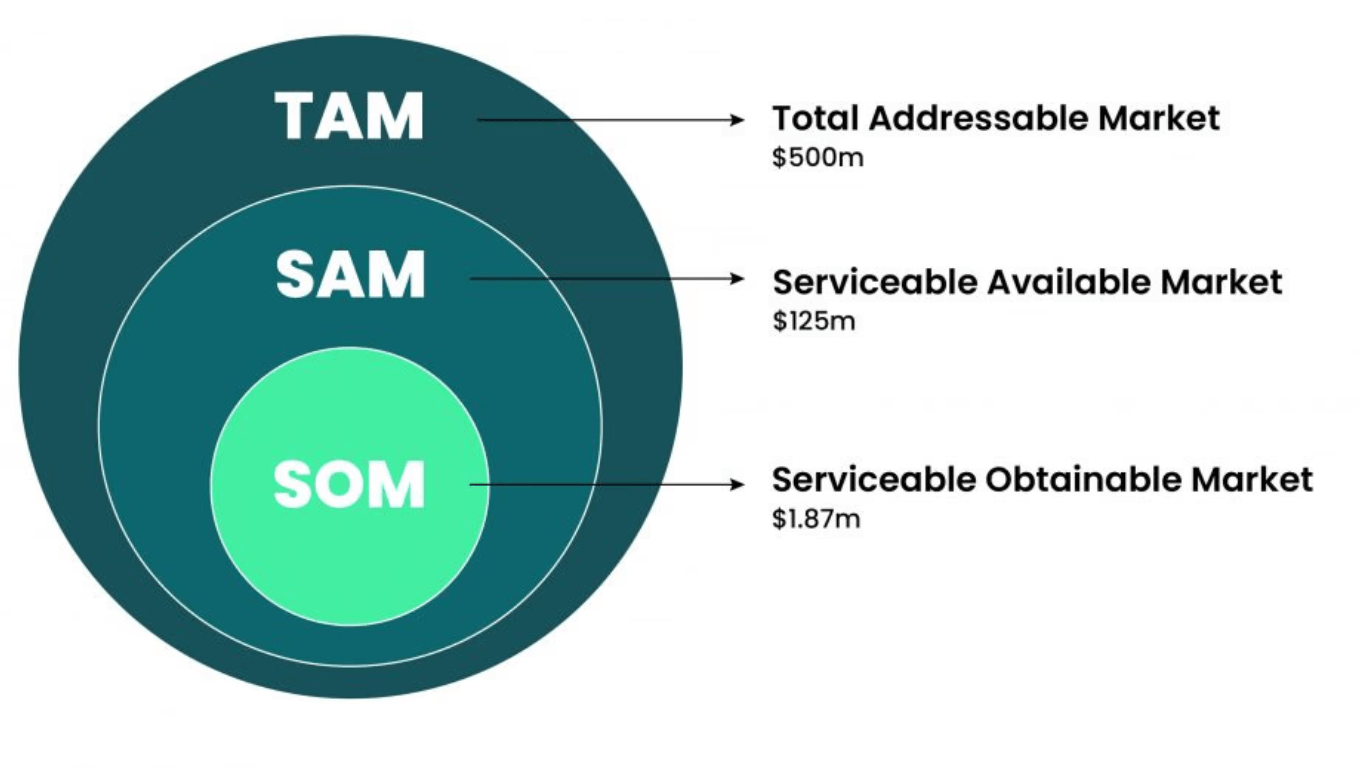Market potential is one of the major tools used in business and entrepreneurship to ensure that there are effective strategies and well-articulated decisions. These three metrics allow a business to assess its market size and identify areas of growth and opportunities, effectively allocating resources.
Definition of TAM
It represents the utmost potential of a market and is usually expressed as annual revenue. The understanding of TAM enables business companies to gauge the rough size of their market and understand how much demand their products may have.
Importance of TAM
Strategic Planning: Knowing the TAM allows businesses to set optimal target growth parameters and align their strategies appropriately. The total market size tells companies to keep their focus on those parts of the market with the most potential.
Investment Decisions: The attractiveness of the opportunity being evaluated by an investor is often affirmed through the TAM. A higher TAM usually means that a company or product is more likely to grow-better news for investors.
Resource Allocation: TAM allows organizations to allocate resources efficiently.
How to calculate TAM
TAM can be calculated using many approaches. This largely depends on whether the product or service is tangible or intangible. The most common techniques include:
Top-Down: TAM is established using industry reports, market research, or government data.
The Bottom-up approach: In the bottom-up approach, a business first takes into consideration its own particular product or service and estimates how many people could be its potential customers. By multiplying that figure with the average revenue per customer, businesses could assess TAM.
Value Theory: It is based on value that a product or a service will bring to the customers. Companies estimate total value of the solution being offered and then compute market size from that.
What is Serviceable Available Market (SAM)?
Definition of SAM
Serviceable available market, or SAM, is that portion of the total addressable market which a company can realistically service. This takes into account those constraints by geographics, regulation, and product specifications.
Why SAM Matters
Targeting and Segmentation: The knowledge of SAM helps firms identify which market segment they can effectively reach and target. This helps to formulate suitable marketing policies and product lines for some market segments.
Resource Planning: SAM helps ensure that firms use resources better, targeting more significant revenue streams.
Sales Forecasting: Based on the segments the companies are likely to capture, they can use SAM for creating more accurate sales forecasts. This helps in setting performance metrics and sales targets that are achievable.
Calculating SAM
The process of calculating SAM usually narrows down the TAM to specific criteria.
Define Target Segments: Identify the customer segments that suit what the business offers and can do. This may imply demographics, industry verticals, or geographic locations, among other requirements.
Estimate Market Size for Target Segments: Apply market research, surveys, or data analytics in estimating how big the targeted segments are. This is done by gathering customer preferences, buying behaviors, and other market trends.
Adjust for Constraints: Determine if there are any constraints or barriers of service for these segments including regulatory constraints, competition or distribution challenges.
What is Serviceable Obtainable Market (SOM)?
Definition of SOM
Serviceable Obtainable Market (SOM) refers to that percentage of the Serviceable Available Market a business will realistically be able to acquire in the near term. It provides a realistic view about the market share which can be garnered within a specific time frame.
Importance of SOM
Short-term planning: SOM keeps the business on course to achieve short term, actionable goals. It makes it easier for businesses to set achievable targets in terms of market capture and measure performance.
Marketing strategy: Knowing SOM allows businesses to tailor marketing efforts to capture maximum impact.
Steps to Calculate SOM
Competitive Landscape: Look for the nature of competition present within the business segments identified. Know the strengths and weaknesses with their market positioning. This would help in determining how much of the market share is realistically achievable.
Marketing Efforts: Analyze the current marketing and sales effort. Understand the brand recognition of the company, the possible customer acquisition, and how much retention of customers happens. This will clear the concept of SOM.
The Interconnectedness of TAM, SAM, and SOM
A market size hierarchy of TAM, SAM, and SOM – this clearly indicates that TAM is the largest market opportunity; SAM relates to those lesser parts or the narrower segments that a business can target, and SOM relates to the realistic portion of the SAM that a business can actually capture.
Strategic planning: Utilizing the knowledge of all three metrics, businesses can create an informed strategic plan as a way to provide strategic framework by concentrating on all three metrics: a long-term goal, short-term targets, and immediate activities. This will lead to better structured market analysis and growth.
Performance Measurement: The process of monitoring progress within TAM, SAM, and SOM measures the performance that a company builds from the marketplace. Businesses can pinpoint what works and what does not, adjust their strategies, and make attainable goals by knowing the nature of the market.
Practical Applications of TAM, SAM, and SOM
1. Business Planning
Business analysis develops a potential target segment, computes the market size, and determines achievable sales points. A well-researched market analysis attracts investors and serves as a guide in making decisions.
TAM, SAM, and SOM help companies better develop their targeted marketing strategies.
3. Product Development
Understanding market dynamics is simply doing new things by coming up with products that the customers might be needing. By analyzing TAM and SAM, it helps companies identify gaps in the marketplace by developing solutions that fulfill unmet demands, enhancing competitiveness, and driving growth.
4. Investor Communication
For startups and emerging businesses, it becomes very important to communicate market potential to investors. Stating clear data of TAM, SAM, and SOM can characterize the business model’s viability and growth prospects. This will build investor confidence and raises an opportunity for increased funding.
5. Competitive Analysis
This helps companies find ways of differentiating their offers and allows the segmentation and strategies to gain market share.
Conclusion
TAM, SAM, and SOM all provide fundamental information concerning a company’s market potential. These metrics allow firms to make informed decisions, rightly allocate resources, and channel their targeted strategies toward growth. And with the ever-changing business landscape, it is only going to become more critical to leverage these concepts to face challenges head-on and capitalize on opportunities in the marketplace.







